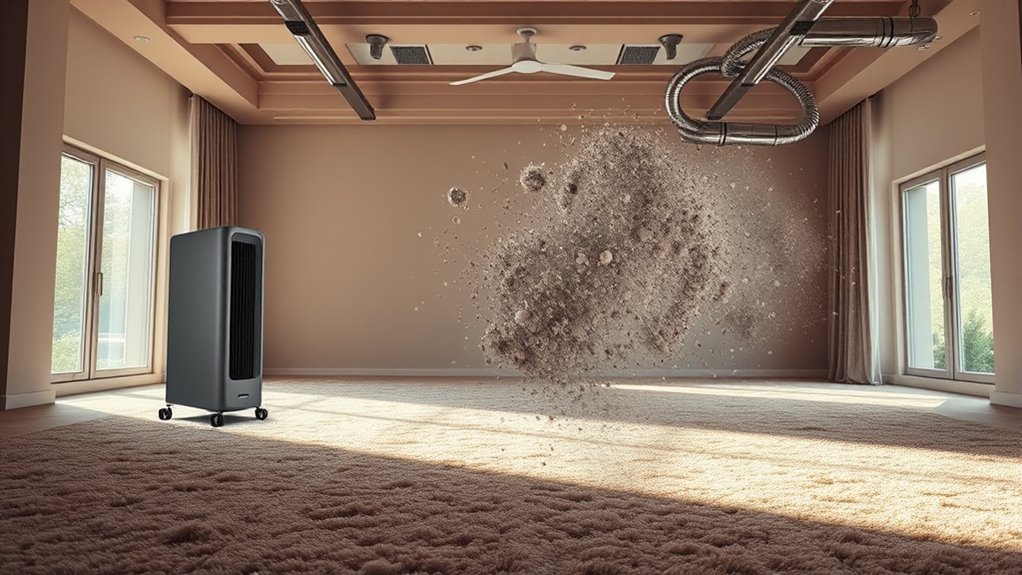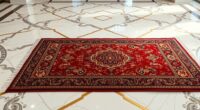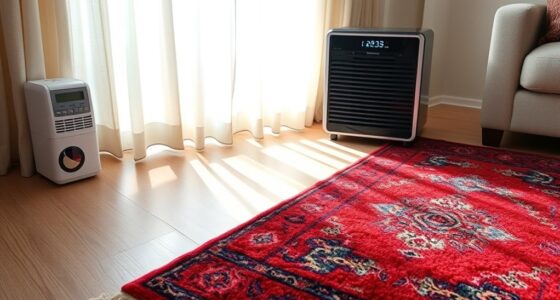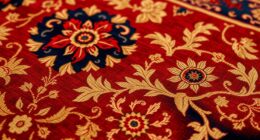To control dust in rug-filled rooms, choose low-pile or flatweave rugs that are easier to clean and trap less dust. Vacuum regularly with a HEPA-filtered vacuum, focusing on high-traffic areas and edges. Use air purifiers and maintain humidity between 40-50% to limit dust mites. Keep outdoor dust out by using doormats and enforcing shoe removal. Proper cleaning routines, ventilation, and staff training will help create a healthier environment—learn more below.
Key Takeaways
- Choose low-pile or flatweave rugs for easier cleaning and reduced dust trapping.
- Vacuum rugs 2-3 times weekly with HEPA-filtered vacuums, focusing on edges and high-traffic areas.
- Maintain indoor humidity between 40-50% to limit dust mite growth and improve air quality.
- Use air purifiers with HEPA filters and keep windows closed during high outdoor pollution days.
- Implement shoe removal policies, use doormats, and reduce clutter to minimize dust entry and accumulation.
Regular Vacuuming Techniques for Effective Dust Removal
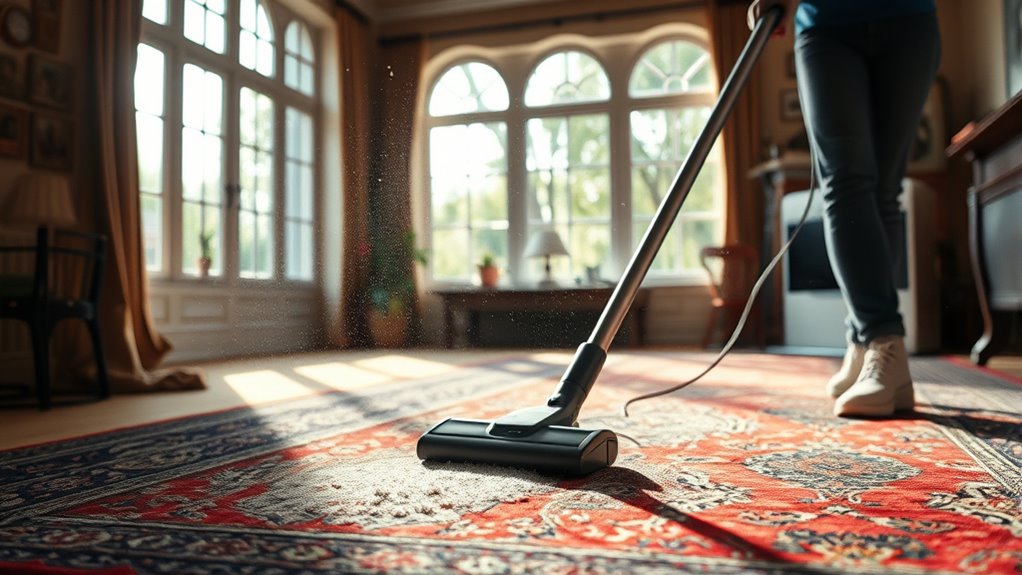
Regular vacuuming is one of the most effective ways to keep dust levels under control. To maintain clean air, you should focus on area rugs, which tend to trap dust and allergens. Vacuum frequently—ideally two to three times a week—to prevent dust from settling deeply into fibers. Use a vacuum with a HEPA filter to trap tiny particles and improve air quality. Pay special attention to high-traffic areas and edges of rugs, where dust accumulates most. Be thorough in your approach; overlapping passes ensure you remove surface dust and debris. Regular vacuuming not only reduces dust but also prolongs the life of your rugs. Keeping up with a consistent schedule is key to maintaining a healthier, dust-free environment in your home.
Choosing Low-Pile and Flatweave Rugs to Minimize Dust Accumulation
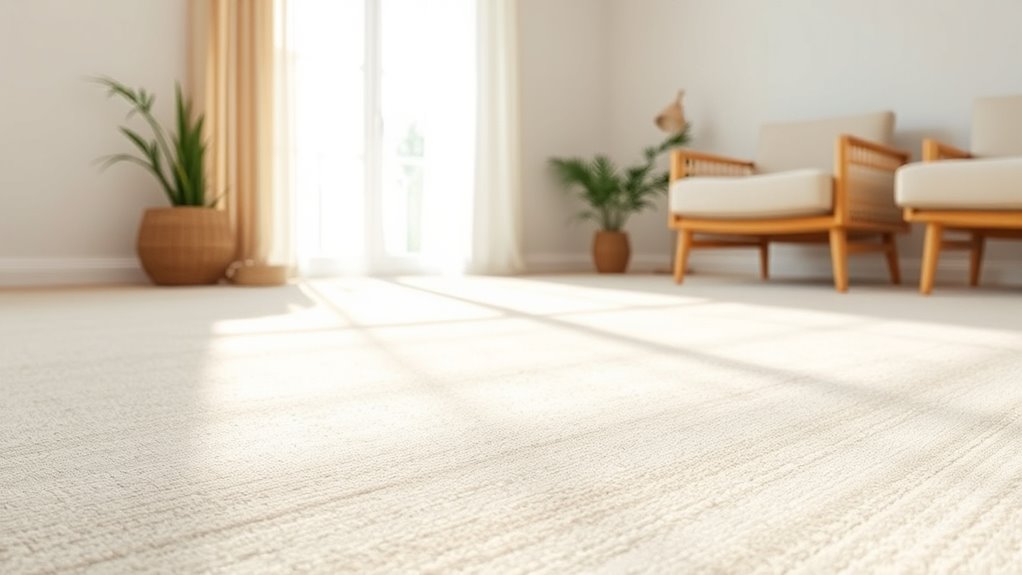
Choosing low-pile and flatweave rugs helps reduce dust trapping, making your space cleaner and healthier. These rugs don’t hold onto dust particles as much as thicker options do. As a result, cleaning becomes easier and quicker, saving you time and effort. Utilizing professional-grade equipment can further improve your cleaning efficiency and dust removal. Additionally, selecting rugs made from natural materials can enhance breathability and further decrease dust accumulation. Incorporating HEPA filtration technology into your cleaning routine can help capture airborne dust particles more effectively. Regularly vacuuming your low-pile rugs with appropriate settings can significantly minimize dust buildup and improve indoor air quality.
Reduced Dust Trapping
To reduce dust buildup in your home, opt for low-pile and flatweave rugs, as these have fewer fibers and surfaces where dust can settle. These rugs naturally trap less dust, but you can enhance their effectiveness with innovative dust barriers that prevent dust from penetrating fibers. Applying dust repellent treatments creates an extra layer of protection, making dust less likely to cling to the rug’s surface. These treatments can be reapplied periodically to maintain their effectiveness. Additionally, vertical storage solutions can help minimize clutter and dust in your space, further improving indoor air quality. Choosing rugs with high color accuracy and appropriate contrast ratios can also improve the visual appeal of your decor while reducing dust visibility. By choosing rugs with these features and using protective measures, you minimize dust retention and improve indoor air quality. This approach is supported by dust control strategies that emphasize the importance of choosing appropriate materials and protective coatings. Implementing fiber composition considerations can also play a significant role in reducing dust accumulation, as certain fibers are less prone to trapping dust particles. This helps keep your space cleaner and reduces the effort needed for ongoing dust management.
Easier Cleaning Routine
Ever wondered why some rugs are easier to maintain than others? Choosing low-pile and flatweave rugs simplifies your rug maintenance routine by reducing dust accumulation. These rug types have fewer fibers and a smoother surface, making it easier to vacuum thoroughly and quickly. Since dust particles don’t settle deeply into the fibers, cleaning becomes more efficient, and you spend less time removing dirt and allergens. Additionally, low-pile rugs are less likely to trap pet hair and debris, which can worsen dust buildup. Regular maintenance with a simple vacuuming schedule keeps dust levels low, improving indoor air quality. Recognizing rug materials that are less prone to trapping dust can also help you select options that are easier to clean and maintain. Using appropriate cleaning tools designed for low-pile surfaces can further enhance dust removal and maintain a healthier environment. Selecting rugs made from dust-resistant materials can also contribute to easier upkeep and cleaner indoor air. By choosing rugs that are easier to clean, you minimize the effort needed for upkeep and create a healthier, dust-free environment in your room.
Using High-Quality Filters in Vacuum Cleaners
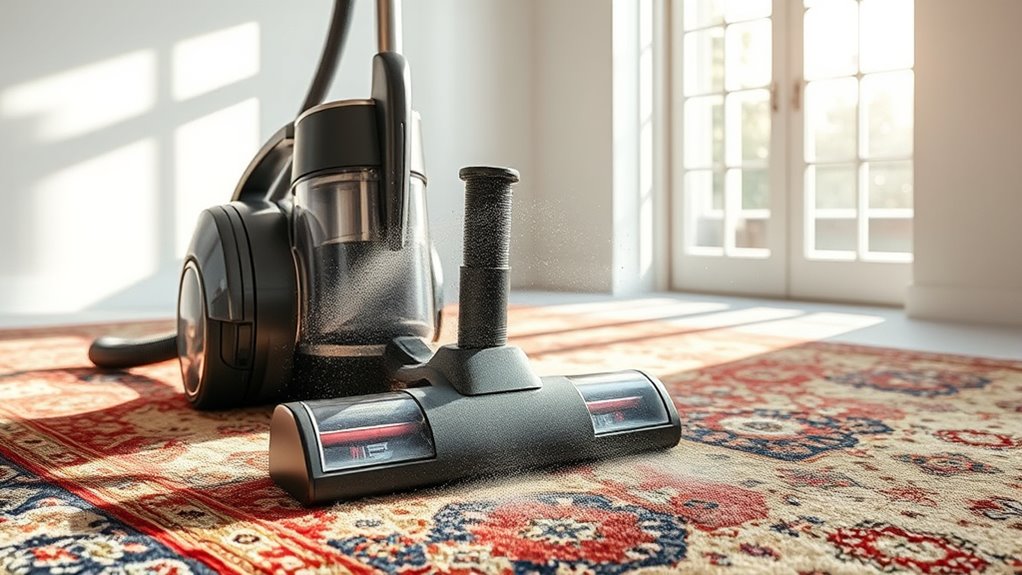
Using high-quality filters in vacuum cleaners is essential for effectively controlling dust and maintaining indoor air quality. HEPA filtration captures tiny particles, including allergens and dust mites, ensuring cleaner air after each vacuuming session. When selecting a vacuum, prioritize models with HEPA filters to maximize dust removal. Regular vacuum maintenance, such as checking and replacing filters as recommended, keeps the system functioning at peak performance. A well-maintained vacuum with a high-quality filter prevents dust from recirculating into the room, which is especially important in rug-filled environments. Investing in good filters and keeping your vacuum properly maintained helps reduce airborne dust, supports healthier indoor air, and lessens the workload of your cleaning routine. Additionally, incorporating AI-powered cleaning technology can further optimize dust control by intelligently adjusting cleaning patterns based on room conditions.
Implementing Professional Deep Cleaning Schedules
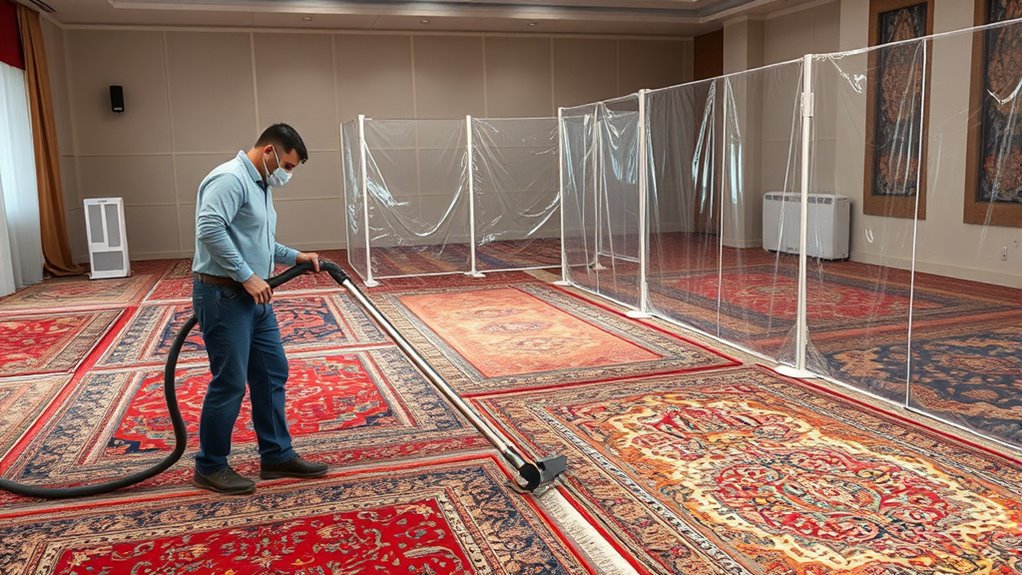
To effectively control dust, you need to set up professional deep cleaning schedules that are consistent and well-planned. Make sure you schedule regular cleanings, use the right equipment, and train your staff on proper protocols. This approach guarantees your space stays cleaner and reduces dust buildup over time. Incorporating proper cleaning techniques ensures the effectiveness of your dust control efforts. Additionally, referring to retail hours can help you plan cleaning sessions during times when the space is less occupied, further enhancing dust management. Considering the use of self-watering plant pots in your cleaning areas can also help maintain a healthy environment by reducing the need for frequent watering and moisture-related dust issues.
Scheduling Regular Cleanings
How often should you schedule professional deep cleaning to effectively control dust buildup? Regular deep cleanings are essential for maintaining rugs and reducing dust accumulation in rug-filled rooms. Ideally, you should arrange professional cleaning every 6 to 12 months, depending on foot traffic and room use. More frequent cleanings help keep dust and allergens in check, especially in high-traffic areas. Maintaining a consistent schedule guarantees your rugs stay in good condition and dust doesn’t settle deeply. By sticking to a routine, you prevent dust from becoming airborne and reduce the need for more intensive cleaning later. Proper scheduling of deep cleanings is a proactive way to improve air quality and extend the life of your rugs, making your space healthier and more comfortable.
Using Proper Equipment
Implementing a professional deep cleaning schedule relies heavily on the right equipment. You need tools that effectively remove dust and debris from rug-filled rooms without spreading particles. High-efficiency vacuums with HEPA filters are essential, as they trap fine dust particles and improve air quality. Use specialized cleaning machines designed for deep carpet extraction, ensuring thorough dirt removal. Microfiber cloths and dusters help capture dust on surfaces without dispersing it into the air. Additionally, consider equipment like air scrubbers or portable filtration units to maintain air purity during cleaning. Investing in quality equipment not only improves cleaning efficiency but also minimizes dust resuspension, creating a healthier environment. Proper equipment is foundational to a deep cleaning process that truly reduces dust and maintains your rug-filled room’s cleanliness.
Staff Training and Protocols
Effective staff training and clear protocols are essential for executing a consistent deep cleaning schedule that minimizes dust and maintains air quality. When your team understands the importance of staff awareness, they are more likely to follow safety procedures diligently. Proper training ensures everyone knows how to handle cleaning equipment correctly, reducing the risk of dust dispersion. Establishing detailed protocols helps standardize cleaning routines, making sure no area is overlooked. Regular refresher sessions reinforce safety procedures and staff awareness, creating a culture of careful, informed cleaning. When your team is well-trained and protocols are clear, your deep cleaning efforts become more effective, leading to cleaner, healthier rug-filled rooms with better air quality.
Utilizing Air Purifiers to Improve Indoor Air Quality
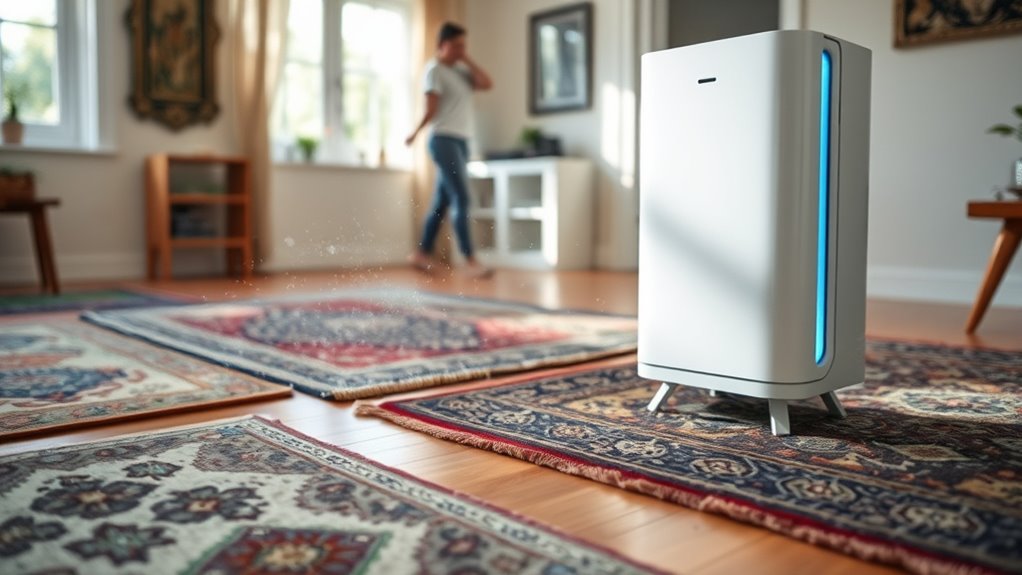
Air purifiers can substantially enhance indoor air quality by removing airborne pollutants such as dust, pollen, pet dander, and smoke. To guarantee they work effectively, you need to keep up with regular air purifier maintenance, including cleaning and inspecting units. Follow the filter replacement schedules recommended by the manufacturer, typically every 3 to 6 months, to maintain peak filtration. Neglecting these schedules can reduce the purifier’s efficiency and allow dust and allergens to circulate freely. Choose a purifier with a HEPA filter for best results, and position it where airflow isn’t obstructed. Regular maintenance and timely filter changes will help you maintain a cleaner, healthier environment, reducing dust buildup and improving overall indoor air quality.
Managing Humidity Levels to Reduce Dust and Allergens
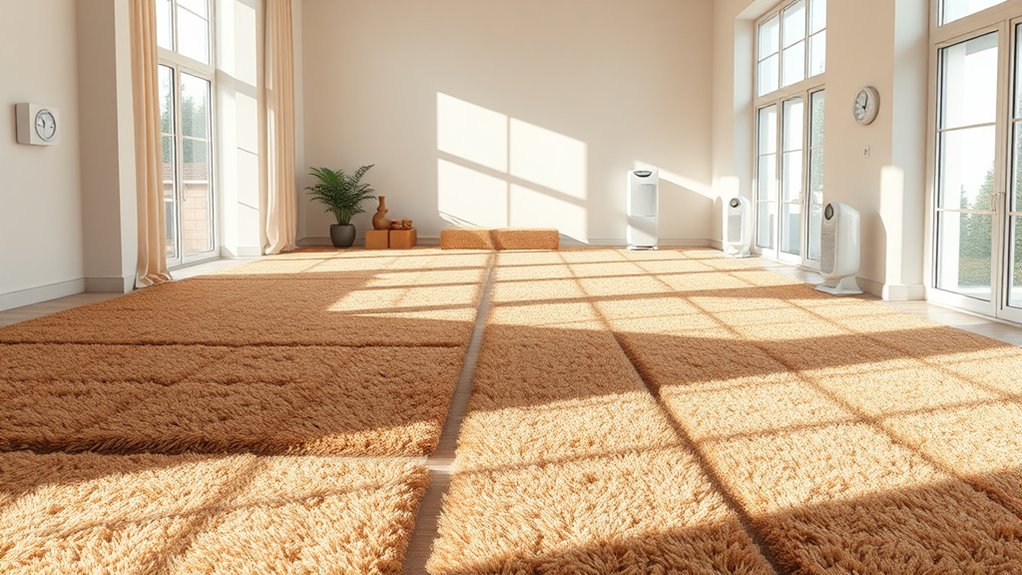
Maintaining proper humidity levels is essential for reducing dust and allergens in your home. When humidity is too low, hygroscopic materials like dust mites thrive, increasing allergen presence. Conversely, high humidity can cause mold growth and make dust particles stick to surfaces. Keeping indoor humidity between 40-50% helps control these issues. This range minimizes dust mite populations, aiding in dust mite mitigation, and prevents dust from becoming airborne. Using a humidifier or dehumidifier allows you to regulate moisture effectively. Consistent humidity levels also reduce static electricity, which can attract dust. By managing humidity carefully, you create an environment less hospitable to dust and allergens, improving indoor air quality and making your space healthier and more comfortable.
Incorporating Doormats and Shoe Removal Policies
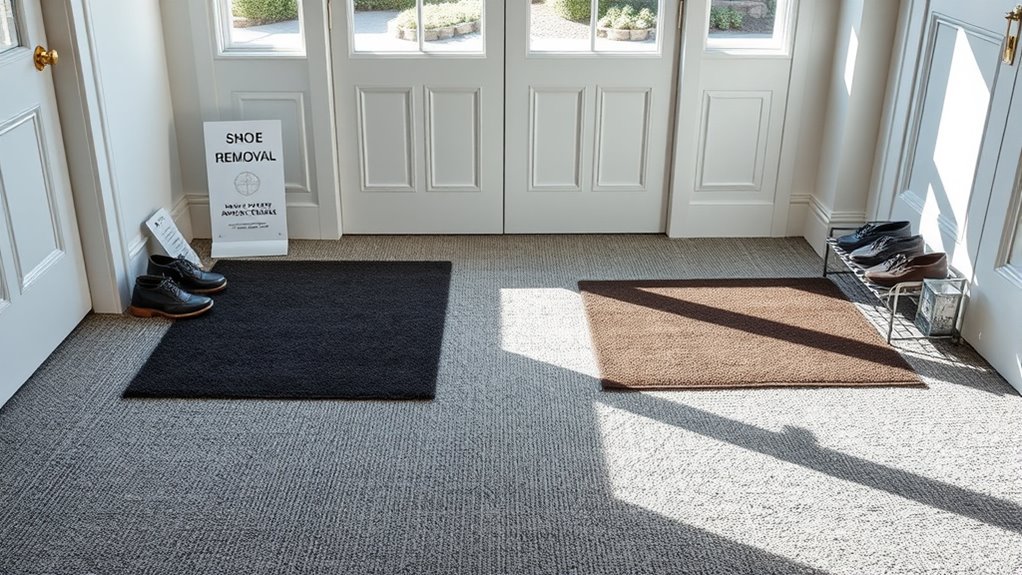
Installing doormats and enforcing shoe removal policies can substantially reduce the amount of dirt and dust tracked inside. Proper placement of mats at entry points maximizes their effectiveness and encourages compliance. Implementing these strategies creates a cleaner environment and simplifies dust control efforts.
Benefits of Doormats
Using doormats and shoe removal policies can substantially reduce the amount of dust tracked into your building. Doormats act as the first line of defense, capturing dirt and dust before it enters your space. Regular mat cleaning enhances dust prevention by removing debris trapped in the fibers, ensuring they stay effective. Here’s why doormats benefit you:
- They minimize dust accumulation on floors, reducing cleaning time.
- They help maintain cleaner rugs and carpets, prolonging their lifespan.
- They contribute to healthier indoor air quality by limiting dust circulation.
Investing in high-quality mats and maintaining them through consistent cleaning makes a noticeable difference. Incorporating doormats is a simple, cost-effective way to improve dust control and keep your environment cleaner and healthier.
Shoe Removal Policies
Implementing a shoe removal policy, alongside doormats, markedly enhances dust control efforts. When you require guests and staff to remove shoes upon entry, you limit the amount of dirt and dust tracked into the room. To support this, guarantee proper floor mat maintenance; clean mats regularly to maximize their dust-trapping effectiveness. Providing convenient shoe storage solutions, like designated shelves or bins, encourages compliance and keeps clutter out of the way. Clear signage reminding everyone to remove shoes also promotes adherence. This combined approach reduces airborne dust particles and minimizes contamination of rug-filled areas. By integrating shoe removal policies with effective doormat use, you create a cleaner environment, making dust control more manageable and improving overall indoor air quality.
Placement Strategies
Effective placement of doormats and shoe removal stations is essential for maximizing dust control. Proper rug placement helps trap dirt before it spreads, while strategic furniture arrangement prevents dust buildup. To optimize your dust control:
- Position doormats at all entrances, ensuring they’re large enough for shoes and are cleaned regularly.
- Place shoe removal stations near entryways to encourage visitors to remove footwear immediately.
- Arrange furniture to avoid blocking airflow and do not place rugs directly against walls, allowing dust to settle on open surfaces and be easily cleaned.
Ensuring Proper Ventilation and Air Circulation
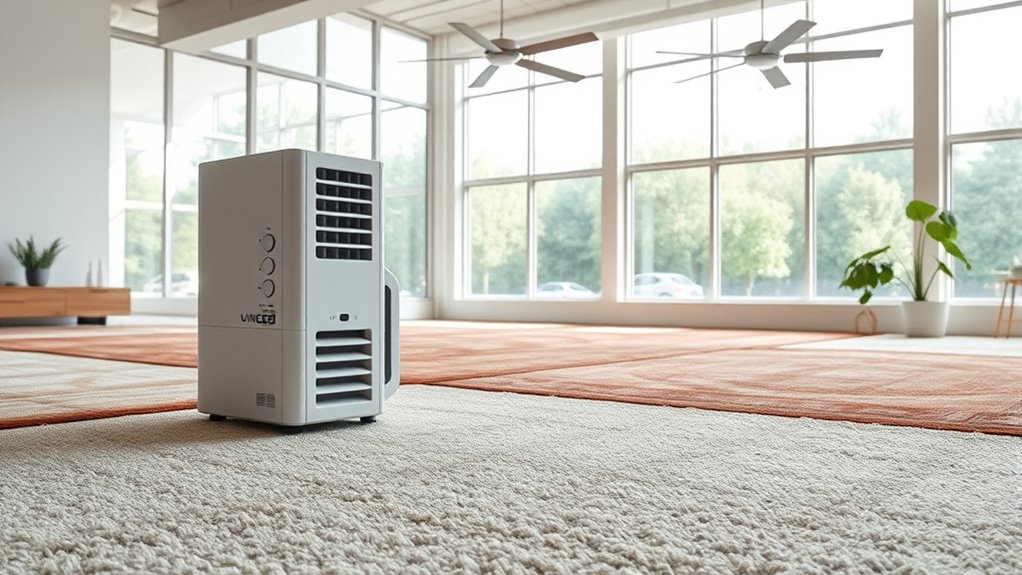
Proper ventilation and air circulation are essential for controlling dust levels in any environment. You should evaluate airflow patterns to ensure dust is effectively moved away from high-traffic areas and vents. Properly designed ventilation systems help maintain consistent airflow, preventing dust from settling and accumulating on rugs. Use exhaust fans or air filtration units to remove airborne particles, reducing dust recirculation. Make sure vents are strategically placed to promote even distribution of fresh air and minimize dead zones where dust could gather. Regularly inspect and maintain your ventilation equipment to keep airflow ideal. By managing airflow patterns and ensuring your ventilation systems work efficiently, you reduce dust build-up, improve indoor air quality, and create a healthier space.
Selecting Rug Materials That Resists Dust and Allergens
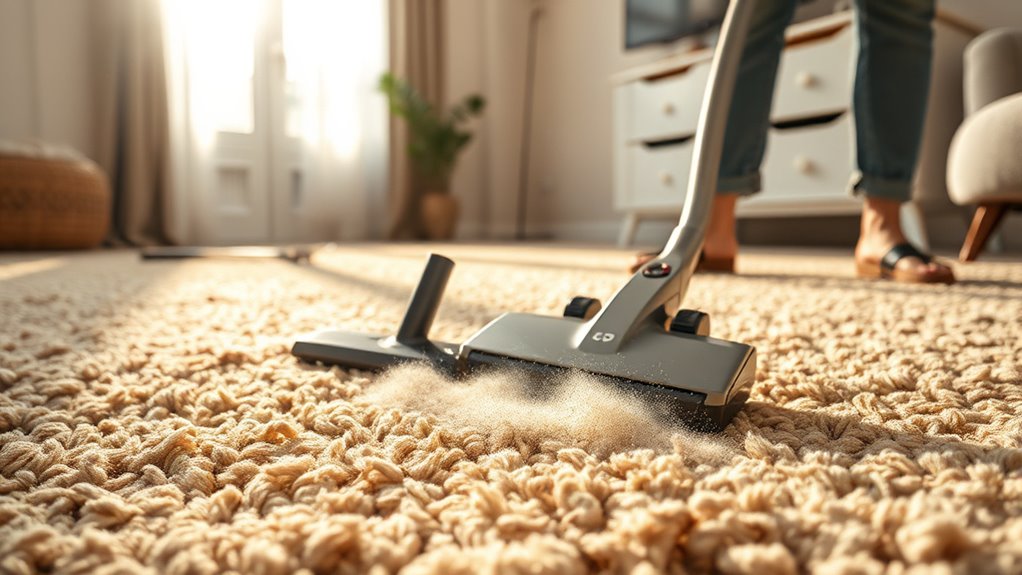
Choosing the right rug materials plays a significant role in controlling dust and allergens in your space. Opt for eco friendly rug materials that are sustainably sourced and less likely to emit volatile compounds. Look for rugs made from allergen resistant fibers, which help prevent dust mites and other allergens from settling. Consider these options:
- Rugs with natural fibers like wool or jute, which resist dust accumulation and are eco friendly.
- Synthetic fibers such as nylon or polyester, designed specifically to repel dust and allergens.
- Low-pile or flat-weave rugs, reducing trapping space for dust and making cleaning easier.
Maintaining a Clean and Dust-Free Surrounding Environment
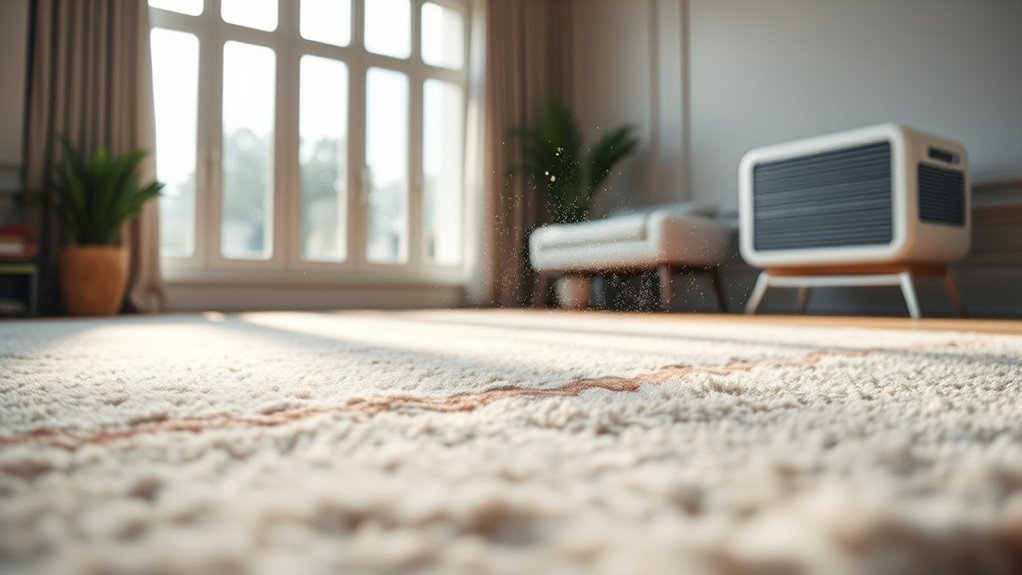
Ever wondered how to keep your environment truly dust-free? Maintaining a clean, dust-free surrounding involves controlling outdoor pollution and dust mites. Regularly dust and vacuum with HEPA filters to trap fine particles. Keep windows closed during high outdoor pollution days to prevent dust and pollutants from entering. Use dust mite control covers on bedding and upholstery to reduce allergens. Make certain proper ventilation to avoid moisture buildup, which encourages dust mites.
| Tip | Benefit |
|---|---|
| Use HEPA filters | Captures fine dust and allergens |
| Keep windows closed | Minimizes outdoor pollution entry |
| Regular cleaning | Reduces dust mite buildup |
Frequently Asked Questions
How Do Dust Control Strategies Vary for Different Rug Materials?
Different rug materials require tailored dust control strategies because their dust absorption varies. For example, wool rugs naturally trap more dust, so regular vacuuming with a HEPA filter is essential. Synthetic rugs absorb less dust but still benefit from consistent cleaning. You should adjust your approach based on the rug material, focusing on effective dust removal techniques to maintain air quality and prolong the rug’s life.
What Are the Environmental Impacts of Various Dust Control Methods?
You consider the environmental impacts of dust control methods by examining air quality improvements and chemical pollutants. Some techniques, like HEPA filtration, effectively enhance air quality without introducing chemicals, reducing pollutants. Others, such as chemical sprays, may improve dust control but can release chemical pollutants into the environment, impacting air and water quality. Balancing efficacy with environmental sustainability helps you choose strategies that protect both indoor air and the broader ecosystem.
Can Specific Cleaning Schedules Prevent Allergen Buildup Effectively?
You can prevent allergen buildup effectively by establishing a consistent cleaning schedule. Regular cleaning frequency minimizes dust and allergens, reducing indoor air pollution. By vacuuming rugs and carpets frequently and wiping surfaces, you actively prevent allergen accumulation. This proactive approach enhances indoor air quality and keeps allergens under control. Staying consistent with your cleaning routine is key to maintaining a healthier environment and preventing allergen issues before they become problematic.
How Do Air Purifiers Compare in Efficiency for Dust Reduction?
Air purifiers with HEPA filters are highly effective for dust reduction because they trap tiny particles that otherwise linger in the air. They enhance air exchange, constantly removing allergens and dust. You’ll notice a significant difference in air quality when using these devices, especially in rug-filled rooms where dust tends to settle. Regular use ensures cleaner air, helping you breathe easier and reducing allergy symptoms.
Are There Cost-Effective Solutions for Maintaining Dust-Free Rug-Filled Rooms?
Think of maintaining a dust-free rug-filled room as tending a delicate garden. You can keep it thriving with cost-effective solutions like regular vacuum maintenance and choosing vacuums with strong dust trapping capabilities. These methods prevent dust from settling and spreading. By staying consistent with vacuuming and investing in quality filters, you control dust efficiently without breaking the bank, creating a healthier, cleaner environment for everyone.
Conclusion
By following these dust control strategies, you can substantially improve your rug-filled room’s air quality. Did you know that regular vacuuming can remove up to 80% of surface dust? Keeping your space clean and well-ventilated not only reduces allergens but also creates a healthier environment for you and your family. Stay consistent with these tips, and you’ll notice a fresher, dust-free room that feels more comfortable and inviting every day.
